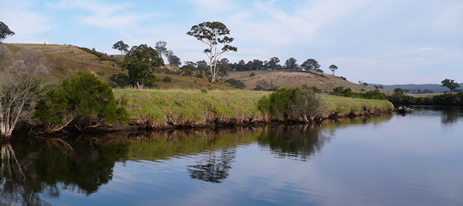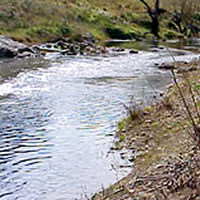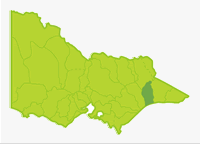Tambo
- Boggy Creek
- Bunga Lake
- Haunted Stream
- King Lake
- Little River
- Nicholson River
- Stony Creek
- Swifts Creek
- Tambo River
- Timbarra River
- Tyers Lake

The Basin extends north for 120 km with most of its area in steep forested mountains. There is only a small southern section of flat farmland and an area of farmland in the middle to upper reaches of the Tambo River valley. Mean annual rainfall in the central Tambo River area is 500-700 mm with 700-1,000 mm in the lower half of the basin. Higher rainfall occurs in the upper reaches of the Timbarra and Nicholson Rivers.
The Tambo and Timbarra Rivers have a reliable flow, with the former never ceasing to flow. The Nicholson River often ceases to flow during summer. Forests vary from very tall Ash and Alpine/subalpine vegetation in the headwater area of the Timbarra River to low mixed species forest in the middle and lower reaches of all the rivers. Both Nicholson and particularly the Tambo Rivers have extensive estuaries with the predominant species being black bream, with estuary perch common in the Tambo River. Access to most rivers is restricted because of the terrain. Some waters in this Basin are commercially fished for long-finned eel and southern short-finned eel.
Freshwater Fish in the Basin

Native Species
- (Large fish): Australian bass, Australian grayling, estuary perch, Gippsland spiny crayfish, long-finned eel, river blackfish and short-finned eel.
- (Small fish): Australian smelt, common galaxias, congoli, Cox's gudgeon ,flathead gudgeon, mountain galaxias, shorthead lamprey, southern pygmy perch and trout galaxias.
Introduced species
- Brown trout, European carp, goldfish and rainbow trout.
Native species in bold are protected in this Basin. Introduced species in bold are declared noxious.
The main feature of the freshwater fish populations is the large population of Australian grayling in the Tambo River. This population has very high conservation value. In contrast to Basins further west, there is only one galaxiid species (common galaxias) present in any number. The rainbow trout are self sustaining populations occurring only in the upper reaches of the Tambo and Timbarra Rivers.
Management
See Introduction for information on Management Agencies and Programs.
Victorian Fisheries Authority
- manages stocking, fisheries policy, compliance with fisheries regulations and contact with anglers.
- Fisheries Management Plan (FMP) (a recent project that provides recreational anglers, government agencies and other stakeholders with clear guidance on fisheries management issues with a regional area over a five year period).
Victorian Fisheries Authority has recently (2009) started to develop an East Gippsland Fishery Management Plan. This new plan will provide for sustainable management of recreational fisheries in the rivers, lakes and impoundments located within the boundaries of the East Gippsland Catchment Management Authority for at least the next five years. This plan is expected to be completed in 2010. - Fish Stocking (stocking of desirable species is based on an approved Victorian Fisheries Authority stocking policy and is reviewed annually via Vic Fish Stock). No waters in this basin are currently stocked. A number of rivers were historically stocked with brown trout but all have proved to be either self-sustaining for this species or unable to support them at all.
Up to date and detailed information on numbers and size of each species stocked throughout Victoria can be found under Fish Stocking in the Fisheries and Aquaculture section of this website or in the annual Vic Fish Stock Report published by the department. - Family Fishing Lakes Program (an ongoing project of stocking small waters within urban areas with larger fish, for junior and disabled anglers- see Introduction for further information). None are established in this Basin.
- Victorian Stream Classification (a project that was completed in November 2010, which classifies each water as a native, salmonid or mixed fishery). Classifications relevant to this basin are:
- Trout - Tambo River and tributaries upstream of and including Haunted Stream. Little River. Timbarra River upstream of Mt Elizabeth Creek. Shady and Stony creeks.
- Native - Tambo River and tributaries downstream of Haunted Stream. Nicholson River.
East Gippsland Catchment Management Authority
- responsible for catchment management and the Victorian River Health Program.
- River Health Program (an on-going State Government initiative to achieve healthy rivers, streams and floodplains). Major priorities are the control and removal of willows and other weeds, re-vegetation and protection of banks, and restoration of bed and bank stability. Work has been carried out in the Nicholson, Tambo and Timbarra Rivers.
Gippsland & Southern Rural Water
- manages farm and irrigation water diversion and development of Stream Flow Management Plans.
- Stream Flow Management Plans (an ongoing project in which various agencies and water user's develop a flow sharing arrangement which ensures an adequate environmental flow allocation for each river in Victoria). No stream flow management plans have yet been developed for waters in this Basin
East Gippsland Water
- manage urban water diversion.
Best Fishing Waters
| Water | Target Species |
|---|---|
| Tambo River (lower) | Black bream, estuary perch |
| Timbarra River | Brown trout |
| Haunted Stream | Brown trout |
| Nicholson River (upper) | River blackfish |
Special Values
Representative Rivers
The Upper Nicholson River has been listed as a Representative River for East Victorian dissected uplands.
Natural Catchment Area
Stony Creek
Ramsar Sites
(Wetlands of international significance - Convention on Wetlands, Ramsar, Iran 1971).
Gippsland Lakes and Lake Tyers.
Threatened Fish Species
The Australian grayling and Cox's gudgeon are listed as threatened species in Victoria. (Department of Sustainability and Environment [DSE] Dec. 2007). A list of Victorian threatened species together with scientific names of species, a definition of the terms used and their national status is available on the DSE web site.
Species in bold type are also listed under the Flora & Fauna Guarantee Act 1988. These species cannot be taken or kept within Victoria without a written order, licence or permit issued by the Governor in Council.

